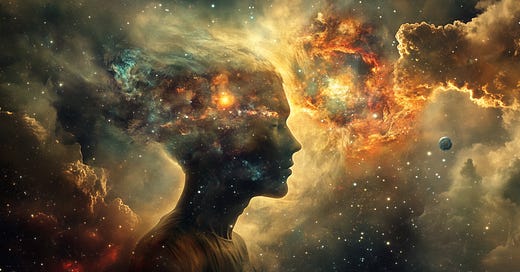I’ve been reading Part 1 of
’s The Evolution of Meaning, titled “A Universal Learning Process.” Brendan and I are going to dialogue on these questions in a few days. I have a good feeling we will learn something new together!You are not your brain, and you’re not just your body either, at least not if you think of your body as just what’s encased within the skin. To really understand what’s going on inside your body, you would need to understand its history, which is as old as the universe. Understanding the body means understanding its environment, and its environment is a process of evolution. Its environment is an evolutionary history. We have to place organisms not just in a spatial environment but also in a temporal environment because, after all, space and time are not two. We distinguish them in our common sense experience, and we need to distinguish them; otherwise, we wouldn’t have two different words for describing simultaneity and succession. However, they are not separable. You can’t measure one without also presupposing the other. There’s no nature at an instant, and there’s no passage which is not also extended. It goes both ways.
So you’re not your brain, and you’re not your body, at least if by body you mean what’s enclosed within your skin. If by body you mean the universe entire, then you are that. You are that not just in space but in time. In time, what can seem like a vast emptiness actually becomes, ultimately, what but light? Or at least the potentiality out of which light at first proceeds? In some sense, physics has taught us that light doesn’t move through space-time. Light is the absolute measure of space and time, at least in relativity theory. If that is the case, then light’s not even really in space or time but constitutes it in a way. Although, I suppose, we are still searching for a connection between light and gravity. Gravity remains mysterious and recedes from our view.
How are we to think of who and what we are as more than just brains and isolated bodies but as microcosmic reincarnations of the One, as miniaturizations of the macrocosm? When we talk about the history of the universe in that case, we can’t seek to pull rabbits out of hats. What I mean by that is we shouldn’t try to convince ourselves that mind could come out of matter, or that value could come out of vacuity, or that aim could suddenly emerge at some point in the cosmic process, whereas before there was mere geometric tumbling. We have to really mind our abstractions here. The idea of matter is one of the most abstract inventions in the history of human consciousness. It’s pure math; it’s pure numerical and geometric relationship, tentatively tied to certain key experiments. However, still, those key experiments could be explained in many other ways. There are still many other viable alternatives to Einstein’s rendering of relativity theory, for example, with Whitehead’s one among them (see The Principle of Relativity, 1922).
The evidence leaves way more theoretical possibilities open on the table, and we have to keep that in mind when we’re dealing with the abstractions of physics. Yes, we want to take seriously phenomena like heat, which thermodynamics tries to study, and phenomena like light and energy, which quantum physics tries to study, and sound, which physics also wants to understand. In each of these cases, there are also artists who want to not just understand but be able to mold and really participate experientially and aesthetically in light, sound, and warmth as well. Warmth, again experientially and not abstractly, is inseparable from mood, emotion, and sense of comfort or discomfort.
Light similarly is not something that we see; it is the medium through which sight is made possible. What we see is colored surfaces, and it seems as though darkness plays just as much a positive role in the creation of those colored surfaces as does light. Maybe darkness is just as invisible as light in a sense. You can’t see in the dark; you need some light. Whereas light is just a revelation, you’re bathed in it, and you cannot turn away from it. I mean, I guess you could, and then you’d face the dark. You’d see your shadow, and the darkness isn’t a revelation; it’s hidden and obscure, kind of like gravity. Gravity is the weakest force in one sense, but in another sense just as universal, if not more so, than anything else, any other force or feeling in the universe. Again, gravity is first and foremost a feeling that we undergo, that we experience. Out of our own sense of heaviness and weight, we have developed the abstraction of mass, but fundamentally we are never going to be able to understand what we mean by mass without making some reference to our own embodied sense of heaviness and momentum as a moving body.
When we try to understand the history of the universe, which we need to in order to understand who and what we are, we have to approach it concretely and intimately, as part of our body. We are a single, unbroken developmental process from the very beginning. If there’s something in us now, at least at the level of our ontology, it must have been there from the beginning. At the level of our phenomenology, perhaps at the level of our phenotype, of course, there’s all sorts of new capacities and things that have been learned, skills and capacities that have been acquired, that we could characterize as creatively emergent. But ontologically, in terms of the basic categories of what the world is made of, you can’t just pretend like you can pull a rabbit out of a hat and get meaning out of motion. Motion is already meaningful. That’s the deeper point here.













Share this post